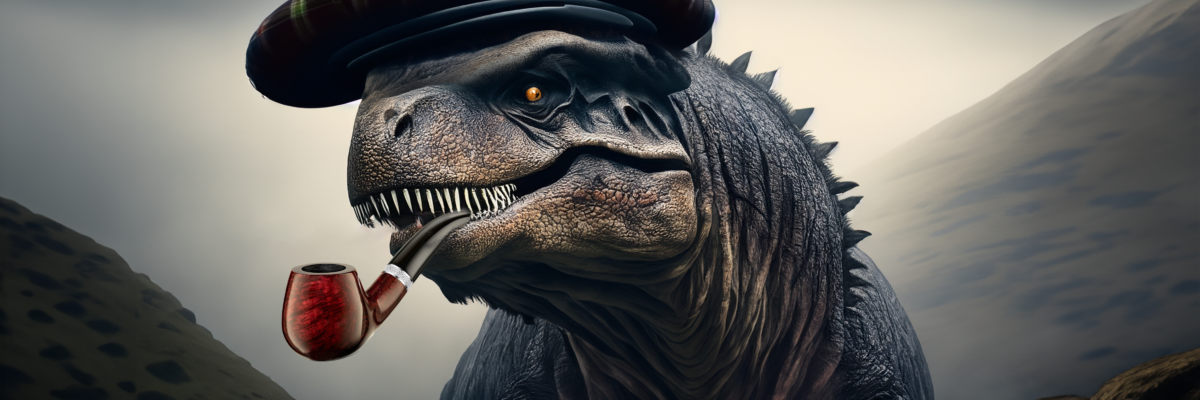
Audio only:
In this episode, Trent responds to a scandalously weak argument against evolution based on claims of human dinosaur coexistence.
Transcription:
Recently Kennedy Hall and Taylor Marshall were discussing the legend of St. George the Dragon Slayer and at one point Hall claimed that medieval depictions of dragons were actually depictions of dinosaurs that survived Noah’s flood.
Other young earth creationists also claim to have evidence of dinosaurs living among human beings that disproves evolution. And today I’m going to talk about why that’s a bad argument Catholics shouldn’t use because of the harm it can cause.
First, I want to address something Hall and Marshall said about Catholic Answers and evolution.
Now, if Marshall just said evolution is false, we wouldn’t be dogmatic about it. Some Catholic Answers staff might agree with him and others might disagree. But if he said, “*the Church* teaches theistic evolution is false”, then I will be very dogmatic because that’s not what the Church teaches.
I want to make it clear that the Catholic church does not have a teaching about the theory of evolution or the extinction of the dinosaurs. You can be a faithful Catholic and deny or accept evolution. You can be a faithful Catholic and believe the sun revolves around the earth. The Church doesn’t teach on these scientific questions. Now Hall says he does not want to dogmatize young earth creationism and I appreciate him saying that. He just asks that people like me not use evolution to evangelize others:
Evangelism means to share the good news of salvation in Christ, and part of that good news is that a loving God made the world. And we *can* use things the Church doesn’t teach to show that. The Church doesn’t teach that atomic theory is true, and the universe is composed of four fundamental forces that are finely tuned for our existence, but this can be really helpful in proving the Gospel truth that God made the world to an atheist.
Hall may be referring to this article by chemist Stacey Trasanco where she explains what she means by evangelizing through evolution. She writes “We should be evangelizing through science, showing others how the ubiquitous order and beauty in creation, from electron orbitals to human life to cosmic galaxies, enriches faith and points beyond the physical realm.”
Also, if Hall wants Catholics to not use evolution to try and prove Catholicism is true, I would just ask him to reciprocate, don’t use bad young earth creationist arguments to try and prove Catholicism is true. You don’t need those arguments to prove Catholicism to a Protestant or an Orthodox young earther because they already believe in a young earth. It’s other doctrines like the papacy that are the major stumbling blocks for them.
But in using these arguments with non-religious people, you create stumbling blocks for those who lack an encounter with Christ, people who truly need the Gospel. This is especially true if you try to convince someone to abandon atheism by saying evolution must be false because we know dinosaurs and human beings lived side by side a few hundred years ago.
One way young earth creationists argue for this is to point to ancient and medieval depictions of creatures that look like dinosaurs and say this shows the artist witnessed dinosaurs in real life. I once saw a Catholic young earth creationist appeal to the supposed dinosaur of Ta Prohm in Northwest Cambodia. One of the reliefs in this temple supposedly that depicts a Stegosaurus that lived among the Cambodians about a thousand years ago.
But the only part of the relief that makes this look like a Stegosaurus are the flaps on the back. But when you zoom out you see that these are decorative petals that can be found throughout the entire relief. If that’s what they are then the creature in question could be an iguana or a Rhino since it doesn’t have other traits unique to Stegosaurus like tail spikes and the head is far too small. Or it could be mythical since at the bottom of the relief there is a half-monkey half dog creature. This certainly doesn’t prove Stegosauruses lived among the Cambodians a thousand years ago, especially since no stegosaurus fossils have been found in Cambodia.
It being a mythical creature also explains images of dragons and other creatures found in ancient and medieval artwork, consider Kennedy Hall’s claim that a medieval Chinese dragon is actually a dinosaur.
People in the past also made descriptions of creatures like the Phoenix or the minotaur but that doesn’t mean those creatures actually existed. Why not think this is a mythical creature?
The source Hall used for the alleged Chinese dinosaur is an article at the Kolbe Center, entitled “Historical Evidence for Dinosaur and Human Co-existence”. They say it’s supposed to be a Coelophysis, but it barely resembles it. Medieval Chinese artists were able to accurately draw horses, deer, and bears why would they give this weird interpretation of dinosaurs unless they weren’t trying to draw a real animal. In ancient cultures most mythical creatures are combinations or exaggerations of existing creatures, and that’s what we see here. One of the other examples the article gives is Bishop Bell’s Behemoths. It says:
This brass engraving was made over 500 years ago, and decorates Bishop Bell’s tomb in England. The two animals depicted are very unambiguous sauropods, but were probably known to the locals of the time as dragons. The animal on the left has a tail that ends in a spiked club, just like the sauropod Shunosaurus. It’s fascinating to consider that these dinosaurs were probably roaming the hillsides of Medieval England!
First, this looks like two lions or cats fighting. But even if we don’t know what these creatures were supposed to be, since they could also be mythical, we can still know what they were not and they weren’t giant sauropods. Cetiosaurus, a sauropod whose fossil was found in England, was almost 50 feet long. If these creatures lived in England until the time of Martin Luther why did no one write about them?
For example, wolves went extinct in England in the 1700’s due to overhunting and before that they were frequently discussed in medieval literature. One 10th century Anglo Saxon king demanded tribute be paid to him in 300 wolf skins and a medieval text called the Anglo Saxon Chronicle describes how January was called “Wolf monath”, the official month of wolf hunting. And don’t be shocked, but absolutely none of these texts describe people hunting or seeing dinosaurs that were twice as big as a London double-decker bus.
However, Hugh Owen, the director or the Kolbe Center says these historical sources do describe dinosaurs in medieval England. He cites the creature Grendel in the 10th century English epic poem Beowulf as an example.
Okay. First, Grendel is a male not a female and Beowulf rips out his arm and kills him before killing Grendel’s mother with a sword. Second, it’s silly to say that this means Grendel was a T-rex with stubby arms and a human being really killed a T-rex in this way. The idea that Grendel was a T-rex attacking 7th century Danish people comes from Creationist Bill Cooper’s book After the Flood. The problem is that, contra Owen and Cooper, Grendel is not specifically described in Beowulf. Grendel is said to be a descendant of Cain and that he is to be larger than any other man and Grendel’s mother is said to be in the form of a woman. They were probably some kind of hominid or human life monster, they definitely weren’t a pair of T-rexes.
Other evidence young earth Catholics present for human dinosaur co-existence isn’t as obviously false as a medieval British brontosaurs or T-rex, but it’s still faulty. At this 2024 Kolbe center conference a speaker listed as Dr. Kevin Mark gives evidence for dinosaurs and humans co-existing by citing the Paluxy river tracks which claim to be fossilized footprints of a human and a dinosaur next to each other.
Mark also presented this thesis to Hall on his show.
But scientists have now shown that the alleged human footprints only look that way because of erosion. This evidence for human dinosaur co-existence is so bad that even other young earth creationists have rejected it. Answers in Genesis lists it under “evidences to be avoided” and back in 1986 John Morris, the son of Henry Morris, one of the founders of modern young earth creationism, said “it would now be improper for creationists to continue to use the Paluxy data as evidence against evolution”
So what does this all mean? If you want to believe that the earth is only thousands of years old and humans co-existed with dinosaurs even just a few hundred years ago, you’re free to believe that. If you are not Catholic and you are also firmly convinced of this, you can keep believing it if you become Catholic, which I hope you do. You could also believe a more defensible claim that dinosaurs didn’t go extinct hundreds of years ago but were wiped out right after they got off Noah’s ark. But I do strongly caution you to not make the claim that evolution is false because T-rexes lived in medieval Denmark or Brontosauruses lived in Reformation era England as an apologetic argument for the faith. At best, it will only reassure other young earth Christians who don’t need to be convinced God exists and alienate people who think religion is an uncritical fairy tale. St. Augustine dealt with a similar controversy in his own time when debating pagan philosophers and here is what he said:
“It often happens that even a non-Christian knows a thing or two about the earth, the sky, the various elements of the world, about the movement and revolution of the stars and even their size and distance, about the nature of animals, shrubs, rocks, and the like, and maintains this knowledge with sure reason and experience. It is offensive and ruinous, something to be avoided at all cost, for a nonbeliever to hear a Christian talking about these things as though with Christian writings as his source, and yet so nonsensically and with such obvious error that the nonbeliever can hardly keep from laughing. . . .The trouble is not so much that the erring fellow is laughed at but that our authors are believed by outsiders to have held those same opinions and so are despised and rejected as untutored men, to the great loss of those for whose salvation we toil…How are they going to believe our books concerning the resurrection of the dead, the hope of eternal life, and the kingdom of heaven when they think they are filled with fallacious writing about things which they know from experience or sure calculation?”
I hope this has been helpful for you all and if you’d like a traditional perspective on this issue I’d recommend Fr. Paul Robinson’s interview on the SSPX and his book The Realist Guide to Religion and Science, both of which are listed in the description below.
Thank you all so much and I hope you have a very blessed day.



